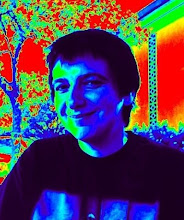
I tried repeatedly to convince her of the beauty of molecules and chemistry. When I once mentioned that with knowledge of chemistry one can produce things that explode, she finally started to pay attention. I invited her over to my place and showed her the thing I was most proud of: my chemistry lab.
My mother, who saw that my interest in chemistry had taken a very theoretical side, with molecular models, atomic orbitals and all that, had in fact decided that I needed a wet lab to make it all more concrete. In those days, there was a toy that was sold for children age 11 and older, which went under the name "The little chemical scientist" and consisted of a collection of glass tubes and various chemical substances with which to make experiments. There were solutions that changed color, things that produced big colorful flames, and my all time favorite: crystals that grew to considerable size. Despite the fact that I was a mere 7 years old, well below the age limit for this toy, my mother bought it for me and I set up my nicely equipped lab.

I doubt it that, nowadays, it would still be possible to buy such toys for children, with a supply of inflammable, toxic substances, and reactions that generate stinking fumes and bursts of flames. People don't trust their children anymore these days it seems.
My lab grew considerably in size the following year, when my mother took on a new job. She began teaching in a school that trained the specialist of the fashion design industry, which already back then constituted that part of the nation's main export.
When one says fashion design, people instinctively think of anorexic models on the catwalk and queer fashion designers dressed in black silk. Well, that's right, but there's a lot more going on behind the scene. There is the large industry of textile, especially silk, production, with the chemical labs that produce the dyes and pigments, the art historians that provide the themes and sources of inspiration for the "collections" that are produced every year, the highly specialized training of the people who learn how to make those drawings. Most of the people working in the field had passed through a specific school, where they were taught the secrets of the trade. I suspect my mother's decision to take on that job was as much motivated by her interest in art history and creative drawing as by the fact that the school had a large and lavishly equipped chemistry lab, with which it made consulting for all the firms in the trade on the production of textile dyes.
The school was closer to the place where we lived, so my mother no longer had a long train commute to get back home in the evening, but she quickly befriended the head of the chemistry labs at her new workplace and given free access to them. So she often stayed extra hours after her classes were over, to enjoy herself with chemistry research. Mostly the lab over there was equipped to investigate the bonds of various new brands of synthetic dye to fabric, especially silk and cotton. A very applied kind of research, driven by the immediate needs of the local industry, but I suppose still interesting enough on the theoretical side to give satisfaction to my mother's scientific curiosity.

So she was still coming home very late, but she sometime brought me spare glasses from their lab for me to use in my small scale home made experiments. Having real glasses from a real chemistry lab made me feel like I was doing real science. It felt great. I even got a lab coat and some extra substances for my experiments when I ran out of the ones contained in the original package.
I managed to impress my Scottish friend with my enhanced lab, but when she tried asking her parents for a box of the same "little chemical scientist" package, they adamantly refused on the ground that the toy box specifically said it was meant only for children at least eleven years of age and to be used only with adult supervision, while we were only seven years old and clearly intended to play with it on our own. That wasn't the end of the story though. She saved pocket money for quite a while until there was enough to get the box. We went to the toy store and with a cleverly improvised story about a present for a non-existent older brother she convinced the clerk to sell us the chemistry box. Out on the sidewalk we carefully inspected our catch. The next question was a more difficult one to solve: how do you hide a fully equipped chemistry lab with burners, flasks, stinking and colorful fumes, from the eyes and nose of inquisitive parents. After debating for a while we came out with a perfect solution: the storage room down in the basement of her apartment building. That lasted for a while, until neighbors became suspicious and alerted her parents. I was banned from their house and forbidden to see her outside of school. At the end of elementary school we went off to different school and lost track of each other. Out of curiosity, now that I am writing up this story in this blog, I looked up her name on Google and found her PhD thesis, in Chemistry, at a respectable American university. It is such a pleasure to see that parents sometime are unable to screw up their children's future, hard as they may try!




